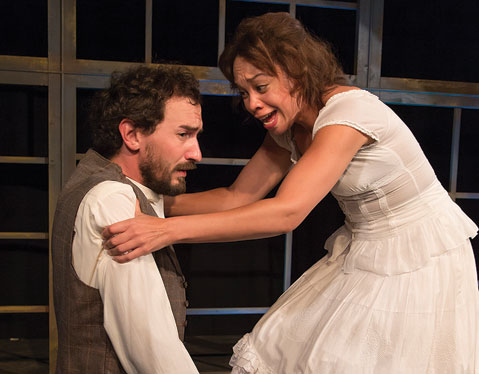Crime and Punishment at Ensemble Theatre Company
Season Opens with Stage Version of the Classic Russian Novel

Want to impress your erudite friends with your knowledge of classic Russian literature without having to actually read 600-page novels? Have we got a show for you! On Saturday night, October 6, the Ensemble Theatre Company kicks off its final season in the Alhecama Theatre with a 90-minute adaptation of Crime and Punishment.
If that feels like cheating, rest assured that the adaptation, by Curt Columbus and Marilyn Campbell, has been enthusiastically received at regional theaters around the country. The New York Times called it an “engrossing” piece that “will banish any bad memories you might have of trying to struggle through Dostoyevsky’s book.”
For the uninitiated (or forgetful), the 1866 novel centers on a 23-year-old former student named Raskolnikov who muses about murdering an elderly pawnbroker. He convinces himself that society’s moral laws don’t apply to him — a belief that gets sorely tested in the course of the story. Recently I discussed the adaptation with Ensemble Artistic Director Jonathan Fox, who freely admits that he had never read the novel until he began preparing for the production.
How did you come to direct an adaptation of a book you had never read? I met Curt Columbus. We were talking about a different project when I read his adaptation and enjoyed it. He and his coauthor don’t try to encompass the whole scope of the novel. The play focuses on seven main characters. Adapting Crime and Punishment for the stage is quite a challenge, and not just because of the novel’s length or the number of characters. The novel is written in such a way that it makes you feel you’re never on solid footing as a reader. The reader, or in this case the audience member, is never quite sure what’s going on — whether something is real or a dream. To capture this, the adaptation is not chronological or linear. That allows the audience to enter into the character’s fractured state of mind. A lot of scenes morph from one location to another seamlessly, because he’s replaying things in his mind. He’s trying to get a grip on what’s real and what’s imaginary.
So how is this classic relevant to a 21st-century audience? One person in the play says, “Compassion is outlawed these days.” That resonates today, as we’re talking about the 47 percent. Raskolnikov is 23. Don’t you think there are a lot of 23-year-olds who are living in their first apartment out of college? They don’t have the kind of creature comforts they’re used to, so they’re pissed off, and they disparage the people who do. Part of that anger was channeled into Occupy Wall Street. In a larger sense, I think it deals with man’s capacity for darkness. I think we all have something in us that is scary for us to look at. Hopefully this will get under people’s skins. The central figure is often sympathetic. He’s extraordinarily compassionate at times. He’s shut into his little world, and yet he’ll give all his money to a family in need. His name is Russian for “split” or “schism.” In the adaptation, he goes through a period of trying to articulate why he does what he does, and finally admits he can’t figure it out. We look for motives, but sometimes there is no motive. It took me a long while before I let myself go in that direction. I wanted the crimes to be related to money or poverty — something I could put my finger on. But every time Dostoyevsky gives you an answer, it gets pulled away.
That moral ambiguity feels quite contemporary. It does. How many of us can say for certain that we would never do something heinous?
4•1•1
Crime and Punishment previews October 4-5, opens at 8 p.m. on Saturday, October 6, and runs through October 21 at the Alhecama Theatre, 914 Santa Barbara Street. For more info, call 965-5400 or visit ensembletheatre.com.



